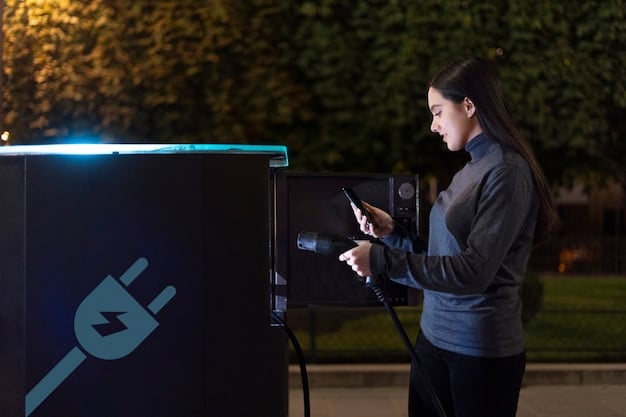Electric Vehicle Charging Standards: CCS, CHAdeMO, and Tesla NACS Explained

Understanding Electric Vehicle Charging Standards: CCS vs. CHAdeMO vs. Tesla’s NACS involves delving into the technologies powering electric vehicle charging, examining their capabilities, regional adoption, and future trends to make informed decisions about EV compatibility and infrastructure.
Navigating the world of electric vehicles (EVs) can be exciting, but understanding the different charging standards can feel like deciphering a new language. Let’s break down the key players – CCS, CHAdeMO, and Tesla’s NACS – and shed light on their differences, benefits, and the future of EV charging.
Understanding CCS (Combined Charging System)
The Combined Charging System, or CCS, is a widely adopted standard in North America and Europe. It essentially combines both AC and DC charging capabilities into a single port on the vehicle, making it a versatile option for EV owners. This means you can use a regular Level 2 charger at home or a public fast-charging station on the go, all with the same port.
CCS Connectors and Charging Levels
CCS utilizes a combo connector, which includes the Type 1 or Type 2 AC charging inlet along with two additional DC pins. This allows for charging at various levels.
- Level 2 AC Charging: This is common for home and workplace charging, providing a moderate charging speed.
- DC Fast Charging: CCS enables high-speed DC charging, significantly reducing charging times at public stations.
The versatility of CCS is a major advantage for drivers who need different charging options depending on their location and urgency. It supports both slow and rapid charging, making it a flexible solution for everyday use and long-distance travel.

Benefits of CCS
CCS offers several benefits. These advantages have contributed to its widespread adoption:
- Versatility: Supports both AC and DC charging, catering to a wide range of charging needs.
- High Power Output: Capable of delivering high power for fast charging, reducing wait times.
- Wide Adoption: Supported by numerous automakers and charging networks, ensuring compatibility.
The combination of convenience and performance makes CCS a solid choice for both manufacturers and consumers. As the EV market expands, the wide availability of CCS charging infrastructure further solidifies its position as a leading standard.
In short, CCS is a versatile and widely adopted charging standard that provides flexibility for EV owners. Its ability to handle both AC and DC charging, coupled with its growing infrastructure, makes it a dependable choice for electric vehicle charging needs.
Exploring CHAdeMO
CHAdeMO, an acronym for “CHArge de MOve,” is another DC fast-charging standard, primarily associated with Japanese automakers like Nissan and Mitsubishi. While its popularity has waned in recent years, particularly in North America and Europe, CHAdeMO was one of the early frontrunners in the fast-charging landscape.
CHAdeMO Specifications and Usage
CHAdeMO connectors are distinct from CCS and NACS connectors, featuring a unique rounded shape. They facilitate high-voltage DC charging, enabling quick replenishment of EV batteries. However, CHAdeMO does not support AC charging, meaning a separate port is required for Level 2 charging.
CHAdeMO chargers can be found at various public charging locations, although their prevalence is decreasing as CCS gains more traction. This is primarily because newer EV models are increasingly equipped with CCS ports, reflecting the industry’s shift toward the combined charging system.
Reasons for Declining Popularity
Several factors have contributed to CHAdeMO’s decline in popularity:
- Lack of AC Charging: Requiring a separate port for AC charging adds complexity and cost to vehicle design.
- Limited Automaker Support: With more automakers adopting CCS, CHAdeMO’s market share has diminished.
- Technological Advancements: CCS offers higher power output and greater efficiency compared to CHAdeMO.

Despite its declining presence, CHAdeMO remains relevant for older EV models and specific geographic regions where it is still supported. For example, many older Nissan Leaf models rely on CHAdeMO for fast charging.
In summation, while CHAdeMO played a significant role in the early days of EV fast charging, its limitations and the industry’s shift toward CCS have led to its reduced popularity. Though still functional for certain vehicles and regions, its long-term viability is uncertain.
Tesla’s NACS (North American Charging Standard)
Tesla’s North American Charging Standard, or NACS, represents Tesla’s proprietary charging connector and protocol. Initially exclusive to Tesla vehicles, NACS has recently gained significant attention as other automakers consider adopting it. This could potentially make it a dominant charging standard in North America.
NACS Connector and Charging Capabilities
The NACS connector is smaller and more streamlined compared to CCS and CHAdeMO connectors. It supports both AC and DC charging, similar to CCS, but uses a single port for all charging levels. This simplifies the design of the vehicle’s charging interface and enhances usability.
Tesla’s Supercharger network, which exclusively uses NACS connectors, is renowned for its reliability and widespread availability. The Supercharger network has been a key selling point for Tesla vehicles, providing convenient and fast charging options for owners across the country.
Potential for Industry-Wide Adoption
The growing interest in NACS from other automakers stems from several factors:
- Compact Design: The smaller connector size allows for more flexible vehicle design.
- High Efficiency: NACS supports efficient energy transfer, reducing charging times.
- Tesla’s Supercharger Network: Access to Tesla’s extensive and reliable charging network is a major draw for other automakers.
If NACS becomes an industry-wide standard, it could streamline the EV charging landscape in North America, benefiting both consumers and manufacturers. However, this transition would require significant investment in infrastructure upgrades and adaptations for existing charging stations.
In conclusion, Tesla’s NACS has the potential to become the dominant charging standard in North America due to its compact design, efficiency, and access to the Supercharger network. Its widespread adoption could simplify EV charging and accelerate the transition to electric mobility.
Comparative Analysis: CCS vs. CHAdeMO vs. NACS
Understanding the distinctions between CCS, CHAdeMO, and Tesla’s NACS is crucial for anyone involved with electric vehicles. Each standard has unique characteristics, strengths, and weaknesses that influence its suitability for different applications and regions. This comparative analysis provides a clear overview of each standard, highlighting their key differences.
Connector Design and Functionality
Each charging standard employs a distinct connector design:
- CCS: Utilizes a combined connector for both AC and DC charging.
- CHAdeMO: Features a unique round connector exclusively for DC fast charging.
- NACS: Employs a compact, single-port connector for both AC and DC charging.
The connector design impacts usability and vehicle design. CCS offers versatility with its combined port, while CHAdeMO requires a separate AC charging port. NACS, with its single port, aims to simplify the charging process and reduce the complexity of vehicle interfaces.
Charging Speed and Power Output
Charging speed and power output are critical factors in the performance of each standard:
- CCS: Capable of delivering high power for fast charging, with ongoing advancements to increase power levels.
- CHAdeMO: Offers fast charging capabilities, although generally lower power output compared to the latest CCS implementations.
- NACS: Supports high-speed charging, leveraging Tesla’s advanced charging technology and Supercharger network.
The ability to deliver high power translates to shorter charging times, making EVs more convenient for long-distance travel. CCS and NACS are continually evolving to support higher power levels, while CHAdeMO’s development has plateaued.
Regional Adoption and Infrastructure
Regional adoption and infrastructure availability vary significantly among the three standards:
- CCS: Widely adopted in North America and Europe, with a growing network of charging stations.
- CHAdeMO: Primarily used in Japan, with decreasing prevalence in other regions.
- NACS: Initially exclusive to Tesla vehicles in North America, but gaining traction as other automakers consider adoption.
The extent of infrastructure support is a key determinant of a standard’s viability. CCS benefits from broad support across multiple regions, while CHAdeMO’s limited adoption restricts its usefulness. NACS, if widely adopted, could reshape the charging landscape in North America.
In brief, CCS leads in versatility and broad adoption, CHAdeMO remains relevant in specific regions with older EVs, and NACS has the potential to become a dominant standard in North America. The choice of charging standard has significant implications for the future of electric vehicle infrastructure and consumer experience.
Future Trends in EV Charging Standards
The evolution of EV charging standards is an ongoing process, driven by technological advancements, market demands, and regulatory changes. Several key trends are shaping the future of EV charging, including the convergence of standards, improvements in charging speed, and the integration of smart charging technologies.
Convergence of Charging Standards
One notable trend is the potential convergence of charging standards, particularly in North America. Tesla’s NACS has garnered interest from other automakers, raising the possibility of a unified charging standard across the region.
If NACS becomes the dominant standard, it would simplify the charging experience for EV owners, eliminate the need for multiple adapters, and streamline the development of charging infrastructure. However, this transition would require significant coordination and investment from automakers, charging networks, and government agencies.
Advancements in Charging Speed and Power
Ongoing research and development efforts are focused on increasing charging speeds and power levels. Higher power chargers can significantly reduce charging times, making EVs more competitive with traditional gasoline vehicles.
CCS is continually being upgraded to support higher power output, with some chargers now capable of delivering up to 350 kW. Similarly, Tesla’s Supercharger network is evolving to provide even faster charging speeds. These advancements will play a crucial role in alleviating range anxiety and promoting the widespread adoption of EVs.
Smart Charging and Grid Integration
Smart charging technologies are becoming increasingly important for managing the growing demand for electricity from EVs. Smart charging involves optimizing charging schedules to reduce strain on the grid, lower electricity costs, and integrate renewable energy sources.
These systems can adjust charging rates based on grid conditions, time-of-use tariffs, and user preferences. Furthermore, vehicle-to-grid (V2G) technology, which allows EVs to supply energy back to the grid, is gaining traction as a means of enhancing grid stability and resilience.
In summary, the future of EV charging standards is characterized by the potential convergence of standards, improvements in charging speed and power, and the integration of smart charging technologies. These trends will collectively shape the EV charging landscape and contribute to a more sustainable and efficient transportation system.
Making Informed Decisions About EV Charging
As the EV market continues to grow, understanding the nuances of different charging standards is essential for making informed decisions about vehicle purchases, charging infrastructure investments, and long-term EV ownership. This section provides guidance on how to navigate the complexities of EV charging and make choices that align with your needs and preferences.
Consider Your Charging Needs
Start by assessing your charging needs based on your driving habits, daily commute, and access to charging facilities. If you primarily drive short distances and have access to home charging, a standard Level 2 charger may suffice. However, if you frequently travel long distances, access to DC fast-charging networks is crucial.
Consider the availability of charging stations in your area and along your frequently traveled routes. Use online resources and mobile apps to locate charging stations and check their compatibility with your vehicle’s charging port. Also, consider the charging speeds offered by different networks and the associated costs.
Understand Charging Standards and Compatibility
Familiarize yourself with the different charging standards—CCS, CHAdeMO, and NACS—and their compatibility with various EV models. When purchasing an EV, verify that the vehicle’s charging port aligns with the available charging infrastructure in your region.
If you own an older EV with a CHAdeMO port, be aware that the availability of CHAdeMO chargers is declining in some areas. Consider investing in an adapter if necessary to access other charging networks. For newer EVs, CCS is generally a safe bet due to its widespread adoption and growing infrastructure.
Stay Informed About Emerging Technologies
Keep abreast of emerging technologies and trends in the EV charging space. Advances in charging speed, wireless charging, and smart charging are continually reshaping the landscape.
Follow industry news and publications to stay informed about the latest developments in charging standards, battery technology, and grid integration. Engage with EV communities and forums to share experiences and learn from other EV owners. By staying informed, you can make well-informed decisions that maximize the benefits of EV ownership.
In conclusion, making informed decisions about EV charging requires understanding your charging needs, becoming familiar with charging standards and compatibility, and staying abreast of emerging technologies. By taking these factors into account, you can confidently navigate the evolving EV charging landscape and optimize your electric vehicle experience.
| Key Point | Brief Description |
|---|---|
| ⚡ CCS Charger | Combines AC and DC charging in one port, widely used in North America and Europe. |
| 🚗 CHAdeMO Charger | DC fast-charging standard mainly used by Japanese automakers like Nissan and Mitsubishi. |
| 🔌 Tesla NACS | Tesla’s proprietary charging connector is gaining attention for potential industry-wide adoption. |
| 🌐 Future Trends | Convergence of standards, enhanced charging speeds, and smart charging technologies are shaping the EV charging landscape. |
FAQ Section
CCS combines AC and DC charging into a single port, while CHAdeMO is exclusively for DC fast charging, requiring a separate port for AC charging. CCS is more widely adopted in North America and Europe.
NACS is compact, supports both AC and DC charging through a single port, and offers high efficiency. Plus, it provides access to Tesla’s extensive and reliable Supercharger network.
CHAdeMO is still relevant for older EVs, especially those from Japanese automakers. However, its prevalence is declining, and it’s not the primary choice for new EV models due to the growing adoption of CCS.
The future includes potential convergence with NACS, faster charging speeds, and smart charging integration that optimizes energy use and reduces grid strain. These improvements will make EV charging more efficient.
Use online resources and mobile apps designed to locate charging stations. Check the compatibility of the charging ports with your EV’s charging inlet, and consider the different networks’ charging speeds and costs.
Conclusion
Understanding EV charging standards like CCS, CHAdeMO, and Tesla’s NACS is key to navigating the evolving electric vehicle landscape. As technology advances and infrastructure expands, staying informed ensures you can make the best choices for your EV needs. Whether it’s choosing the right vehicle or planning your charging strategy, knowledge is power in the electric revolution.





